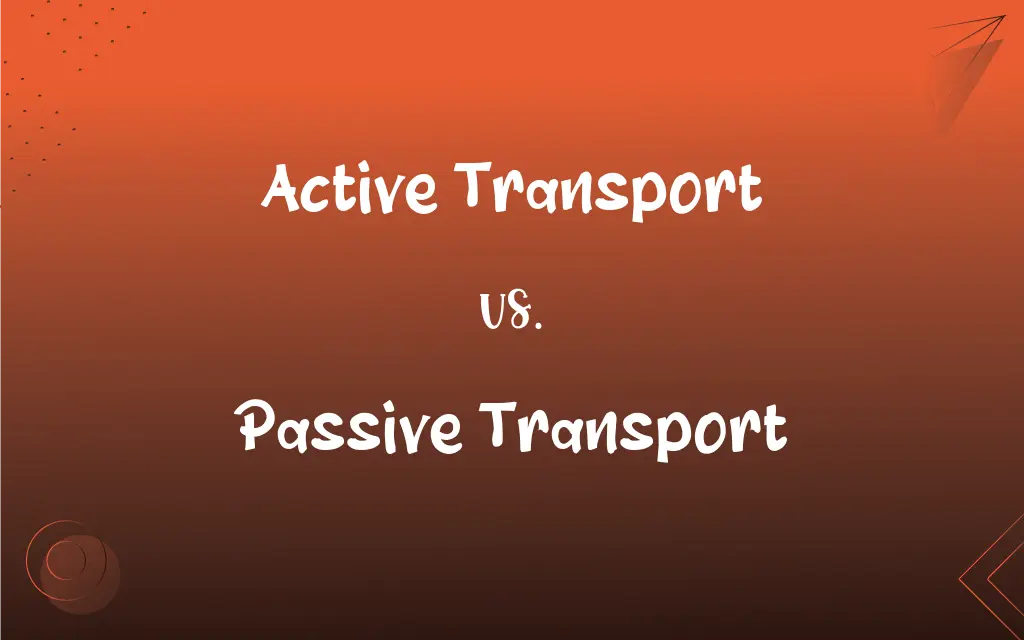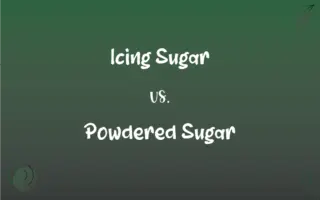Active Transport vs. Passive Transport: What's the Difference?
Edited by Janet White || By Harlon Moss || Updated on October 7, 2023
Active transport requires energy to move substances across cell membranes, while passive transport does so without energy, utilizing concentration gradients.

Key Differences
Active transport is a biological process that demands energy to transport molecules against a concentration gradient. Passive transport, inversely, enables molecules to move down a concentration gradient without utilizing energy.
An active transport system often involves proteins to pump molecules across cell membranes. Conversely, passive transport allows molecules to naturally flow from a region of high concentration to a region of low concentration without such pumps.
Active transport empowers cells to maintain internal concentrations of molecules that might be different from their surroundings. Passive transport, on the other hand, doesn’t enable cells to counteract the external environment, instead, aligning internal concentrations with external ones.
The active transport mechanism enables the accumulation of essential substances within a cell despite external scarcities. While passive transport generally restricts cellular accumulation capacities based on environmental abundance or scarcity.
Active transport is critical for creating a specific intracellular environment, sustaining life processes. Passive transport, while still vital, may not be sufficient to maintain the required homeostatic balance in cells during certain biological processes.
ADVERTISEMENT
Comparison Chart
Energy Requirement
Requires energy (often ATP).
Does not require energy.
Direction
Against concentration gradient.
Along the concentration gradient.
Transport Proteins
Often involves transport proteins.
May or may not involve transport proteins.
Example Molecules
Ions, large cells.
Oxygen, carbon dioxide.
Speed & Efficiency
Can be rapid and precise.
Dependent on concentration gradients.
ADVERTISEMENT
Active Transport and Passive Transport Definitions
Active Transport
Maintains cellular homeostasis by energy-driven transport.
Active transport in neurons is vital for nerve impulse transmission.
Passive Transport
Mechanism moving particles from high to low concentration.
Passive transport ensures even distribution of ions in solution.
Active Transport
Utilizes transport proteins and energy to move substances.
Active transport pumps sodium ions out of the cell.
Passive Transport
Molecules move along their concentration gradient naturally.
Oxygen enters cells through passive transport.
Active Transport
A cellular process requiring energy for movement.
Cells use active transport to intake nutrients against a gradient.
Passive Transport
Transports cellular substances without energy expenditure.
Passive transport facilitates the osmosis of water in cells.
Active Transport
Allows cells to manage internal concentrations purposefully.
Cells employ active transport to maintain pH balance.
Passive Transport
Relies on intrinsic kinetic energy for molecule movement.
Glucose often enters cells via passive transport.
Active Transport
Involves moving molecules against a concentration gradient.
Active transport enables roots to absorb minerals from the soil.
Passive Transport
Involves no cellular energy to facilitate movement.
Passive transport enables simple diffusion of gases.
FAQs
Is active transport dependent on cellular energy?
Yes, active transport usually depends on cellular energy, often in the form of ATP.
What is the primary distinction between active and passive transport?
Active transport requires energy to move substances against a gradient, while passive transport does not.
What is a common example of a molecule moved by active transport?
Sodium ions (Na+) are commonly moved via active transport in cells.
Can passive transport occur without any protein channels or carriers?
Yes, passive transport can occur without these structures through simple diffusion.
What is a concentration gradient in the context of passive transport?
It’s the variation in concentration of a substance from one location to another.
Can active transport occur against the direction of a concentration gradient?
Yes, active transport typically moves substances against a concentration gradient.
Does active transport always involve membrane proteins?
Most active transport mechanisms involve transport proteins to move substances across membranes.
Is passive transport influenced by external environmental factors?
Yes, passive transport can be influenced by factors like concentration gradients.
Are both active and passive transport specific to biological systems?
Primarily yes, these terms are predominantly used in the context of cellular and biological systems.
Can passive transport facilitate the movement of water?
Yes, water can move through passive transport via a process called osmosis.
Is the energy requirement a disadvantage of active transport?
While it uses energy, active transport allows cells to achieve desired concentrations of substances, which can be crucial.
Can active transport work in an isolated system without external influence?
Not practically, as active transport typically requires energy and a substance to move.
Can a cell control the rate of passive transport?
Cells may have limited control by altering permeability but cannot fully regulate passive transport.
Is passive transport capable of moving ions across a membrane?
Yes, ions can move via passive transport if there's a concentration gradient and a pathway.
Does passive transport solely rely on the natural movement of particles?
Generally, yes. Passive transport utilizes the inherent motion of particles and existing gradients.
What is one method through which active transport can be powered?
The hydrolysis of ATP often provides energy for active transport.
Does passive transport have an upper limit for efficiency?
Yes, passive transport is limited by the size of the concentration gradient.
Is passive transport effective for maintaining cellular homeostasis?
While vital, passive transport alone may not be sufficient for maintaining cellular homeostasis.
Why is active transport crucial for cell survival?
Active transport helps cells maintain specific internal environments, regulating essential substances.
Can active transport establish concentration gradients?
Yes, active transport can create and maintain concentration gradients by moving substances against their natural flow.
About Author
Written by
Harlon MossHarlon is a seasoned quality moderator and accomplished content writer for Difference Wiki. An alumnus of the prestigious University of California, he earned his degree in Computer Science. Leveraging his academic background, Harlon brings a meticulous and informed perspective to his work, ensuring content accuracy and excellence.
Edited by
Janet WhiteJanet White has been an esteemed writer and blogger for Difference Wiki. Holding a Master's degree in Science and Medical Journalism from the prestigious Boston University, she has consistently demonstrated her expertise and passion for her field. When she's not immersed in her work, Janet relishes her time exercising, delving into a good book, and cherishing moments with friends and family.































































